
|
It approached to the sun down to 0.73 A.U. on Mar. 24, and brightened up to 4.7 mag (Mar. 11, Michael Mattiazzo). Now it is fading. But it is still bright as 9.2 mag (July 18, Juan Jose Gonzalez). In the Northern Hemisphere, it keeps observable in good condition while fading gradually. In the Southern Hemisphere, it will never be observable again.
Date(TT) R.A. (2000) Decl. Delta r Elong. m1 Best Time(A, h)
July 27 22 25.32 68 26.2 1.999 2.236 89 9.3 2:09 (180,-13)
Aug. 3 21 44.22 70 1.0 2.062 2.329 91 9.5 1:00 (180,-15)
|

|
The condition is worst and the comet will be hardly observable in this apparition. In the Northern Hemisphere, it will be observable in autumn when the comet will be fainter than 16 mag.
Date(TT) R.A. (2000) Decl. Delta r Elong. m1 Best Time(A, h)
July 27 7 31.40 23 34.3 2.042 1.079 13 10.2 5:30 (248,-10)
Aug. 3 8 2.00 23 6.4 2.068 1.103 13 10.3 5:26 (249,-11)
|
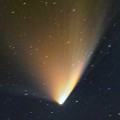
|
It passed the perihelion on Mar. 10, and brightened up to 0-1 mag. Now it is fading. It has already faded down to 10.8 mag (July 18, Juan Jose Gonzalez). It is observable in good condition in the Northern Hemisphere. It will be observable in the extremely low sky from mid August to mid September also in the Southern Hemisphere.
Date(TT) R.A. (2000) Decl. Delta r Elong. m1 Best Time(A, h)
July 27 14 37.79 53 41.1 2.731 2.681 76 11.5 18:42 (176, 1)
Aug. 3 14 42.26 50 39.1 2.864 2.778 74 11.7 18:46 (172, 4)
|

|
Brightening very rapidly near the perihelion as predicted. Now it is 13.3 mag and already visible visually (July 8, Chris Wyatt). It will reach up to 12 mag in the evening sky from July to August.
Date(TT) R.A. (2000) Decl. Delta r Elong. m1 Best Time(A, h)
July 27 12 24.57 6 38.5 1.218 1.121 59 12.0 18:42 (131, 35)
Aug. 3 12 55.38 5 53.1 1.235 1.147 60 12.3 18:46 (130, 35)
|
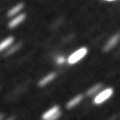
|
It brightened up to 13.6 mag until spring (May 5, Hiroshi Abe). It will brighten up to 12 mag from summer to autumn. In the Southern Hemisphere, it is appearing in the morning sky again. It will keep observable in good condition for a long time until 2014 summer when the comet fades out. It will never be observable again in the Northern Hemisphere.
Date(TT) R.A. (2000) Decl. Delta r Elong. m1 Best Time(A, h)
July 27 6 58.24 10 37.2 2.368 1.484 22 12.6 5:30 (254, 4)
Aug. 3 7 14.80 6 57.9 2.310 1.468 26 12.5 5:26 (256, 8)
|
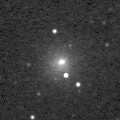
|
New bright comet discovered in the extremely low sky at dawn. Now it is 11.0 mag (July 18, Juan Jose Gonzalez). It keeps 12-13 mag until autumn, but it keeps locating extremely low in the morning sky. It is not observable until November in the Southern Hemisphere.
Date(TT) R.A. (2000) Decl. Delta r Elong. m1 Best Time(A, h)
July 27 7 10.29 41 48.5 2.074 1.264 27 12.6 5:30 (230,-16)
Aug. 3 7 43.65 39 10.6 2.060 1.235 26 12.5 5:26 (233,-16)
|

|
It is expected to be a great comet in 2013 autumn when the comet approaches to the sun down to only 0.01 A.U. It keeps visible with naked eyes from November to January, and can be extremely bright as Venus or more at the highlight. However, the brightening has declined at 15.5 mag from January through May in 2013. Now it is not observable. The condition is excellent in the Northern Hemisphere. It will appear in the morning sky again in late August, then it keeps observable almost all through the period of brightening, at the highlight, and of fading. The condition is not good in the Southern Hemisphere. It is not observable at all the latter part of the highlight, and it keeps low all through the period.
Date(TT) R.A. (2000) Decl. Delta r Elong. m1 Best Time(A, h)
July 27 7 53.98 25 17.0 3.732 2.735 9 12.7 5:30 (249,-15)
Aug. 3 8 2.46 24 46.8 3.606 2.631 13 12.5 5:26 (248,-12)
|
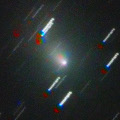
|
Now it is so bright as 11.2 mag (July 3, Con Stoitsis). In the Southern Hemisphere, it keeps observable for a long time until the comet fades out, although it keeps locating low. It will never be observable again in the Northern Hemisphere.
Date(TT) R.A. (2000) Decl. Delta r Elong. m1 Best Time(A, h)
July 27 8 9.19 -26 13.5 2.417 1.855 45 13.1 5:30 (294, 11)
Aug. 3 8 27.31 -29 26.2 2.445 1.910 47 13.3 5:26 (297, 14)
|

|
It brightened up to 12 mag in 2012. It is bright as 13.3 mag still now (July 1, Hidetaka Sato). It keeps 13-14 mag until autumn. It locates somewhat low in the Northern Hemisphere.
Date(TT) R.A. (2000) Decl. Delta r Elong. m1 Best Time(A, h)
July 27 19 27.71 -35 44.6 2.063 3.034 159 13.1 23:06 ( 0, 89)
Aug. 3 19 22.97 -36 7.4 2.107 3.045 152 13.2 22:34 ( 0, 89)
|
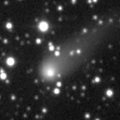
|
Now it is 13.1 mag (July 13, D. Sidorko). It keeps bright at 13-14 mag for a long time until 2014. It keeps observable for a long time in the Northern Hemisphere. It locates somewhat low in the Southern Hemisphere.
Date(TT) R.A. (2000) Decl. Delta r Elong. m1 Best Time(A, h)
July 27 20 11.29 30 45.7 5.217 5.919 129 13.2 23:49 (180, 24)
Aug. 3 20 3.50 29 48.2 5.206 5.923 131 13.2 23:14 (180, 25)
|

|
It brightened up to 11-12 mag in 2012. Now it is bright as 13.7 mag (July 24, Taras Prystavski). It keeps observable until July in the Northern Hemisphere, or until September in the Southern Hemisphere.
Date(TT) R.A. (2000) Decl. Delta r Elong. m1 Best Time(A, h)
July 27 13 11.49 -9 55.0 6.367 6.205 76 13.4 18:42 (128, 54)
Aug. 3 13 10.70 -9 56.1 6.517 6.234 69 13.5 18:46 (119, 49)
|
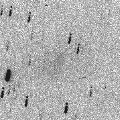
|
Now it is 16.9 mag (June 9, Hidetaka Sato). It will approach to the Sun down to 0.9 A.U., and to the Earth down to 0.4 A.U. in September. So it was expected to brighten up to 11-12 mag. However, it looks extremely diffuse on July 12 by Michael Jager. So the comet can be already disintegrated. In the Northern Hemisphere, it keeps observable in good condition until mid September. In the Southern Hemisphre, it will getting higher after August, and it keeps observable in good condition after that.
Date(TT) R.A. (2000) Decl. Delta r Elong. m1 Best Time(A, h)
July 27 13 52.10 39 37.1 0.904 1.127 71 14.3 18:42 (166, 14)
Aug. 3 14 2.92 35 47.6 0.819 1.064 69 13.8 18:46 (161, 16)
|

|
Now it is bright as 12.2 mag (July 24, Taras Prystavski).
Date(TT) R.A. (2000) Decl. Delta r Elong. m1 Best Time(A, h)
July 27 13 40.34 -20 30.7 6.177 6.204 86 13.9 18:42 (123, 67)
Aug. 3 13 42.80 -20 33.8 6.285 6.203 80 13.9 18:46 (113, 62)
|

|
Now it is 14.5 mag (June 11, Sandor Szabo). It keeps 13 mag and observable in good condition in the Northern Hemisphere for a long time from 2013 to 2014. But it locates low in July and August. In the Southern Hemisphere, it is not observable until 2014 autumn.
Date(TT) R.A. (2000) Decl. Delta r Elong. m1 Best Time(A, h)
July 27 9 26.46 51 8.2 4.512 3.715 34 14.0 18:42 (137,-23)
Aug. 3 9 32.31 51 30.2 4.478 3.691 34 13.9 18:46 (136,-27)
|

|
Big asteroid discovered in 1906. It suddenly showed the cometary activity on Dec. 11, 2010, probably due to an impact of a small object. It has already turned to be stellar.
Date(TT) R.A. (2000) Decl. Delta r Elong. m1 Best Time(A, h)
July 27 1 4.33 -12 27.5 2.422 2.969 112 14.1 4:46 (180, 67)
Aug. 3 1 5.73 -12 53.2 2.353 2.980 118 14.0 4:20 (180, 68)
|
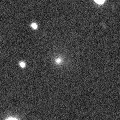
|
Now it is 15.5 mag (July 16, Sandor Szabo). It brightens up to 14 mag in July and August. In the Southern Hemisphere, it keeps observable for a long time until the comet fades out. It keeps observable in good condition until September also in the Northern Hemisphere.
Date(TT) R.A. (2000) Decl. Delta r Elong. m1 Best Time(A, h)
July 27 20 18.76 -2 56.0 1.350 2.342 163 14.3 0:02 (180, 58)
Aug. 3 19 55.50 -8 42.3 1.339 2.330 163 14.3 23:05 (180, 64)
|
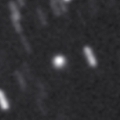
|
Now it is 14.3 mag and visible visually (July 8, Gabor Santa and Krisztian Sarneczky). It is expected to brighten up to 5-6 mag in 2014 autumn. In 2013, it keeps observable in good condition until autumn when it brigthens up to 13-14 mag.
Date(TT) R.A. (2000) Decl. Delta r Elong. m1 Best Time(A, h)
July 27 15 51.63 20 14.7 4.781 5.094 102 14.5 19:30 (180, 35)
Aug. 3 15 47.17 19 40.0 4.812 5.027 96 14.4 18:58 (180, 35)
|
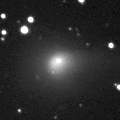
|
Now it is bright as 13.8 mag (July 16, Sandor Szabo). It keeps locating in the morning sky for a long time. I will keep the current brightness for a long time.
Date(TT) R.A. (2000) Decl. Delta r Elong. m1 Best Time(A, h)
July 27 1 20.07 10 55.1 1.953 2.372 101 14.7 5:02 (180, 44)
Aug. 3 1 22.66 10 15.7 1.934 2.442 107 14.8 4:37 (180, 45)
|
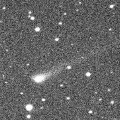
|
Now it is 14.3 mag (July 8, Chris Wyatt). It keeps bright as 13-14 mag for a long time from 2013 to 2014.
Date(TT) R.A. (2000) Decl. Delta r Elong. m1 Best Time(A, h)
July 27 14 14.61 -12 37.3 3.082 3.274 91 14.7 18:42 (151, 65)
Aug. 3 14 19.08 -13 14.2 3.168 3.263 86 14.7 18:46 (137, 63)
|
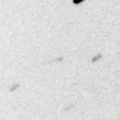
|
It will approach to the sun down to 0.8 a.u. on Aug. 6. Brightening very rapidly. Now it is bright as 15.3 mag (July 24, Hidetaka Sato). In the Southern Hemisphere, it keeps observable at 15 mag in good condition in the evening sky until September. It is not observable in the Northern Hemisphere.
Date(TT) R.A. (2000) Decl. Delta r Elong. m1 Best Time(A, h)
July 27 11 26.31 1 18.9 1.007 0.820 47 15.5 18:42 (114, 28)
Aug. 3 11 49.43 -3 38.1 0.930 0.803 48 15.2 18:46 (108, 30)
|

|
Few observations have been reported recently. It keeps 15 mag in 2013. It is observable in good condition in the Southern Hemisphere. It will be observable in good condition also in the Northern Hemisphere after August.
Date(TT) R.A. (2000) Decl. Delta r Elong. m1 Best Time(A, h)
July 27 4 9.60 -23 31.8 7.027 6.844 75 15.2 5:30 (259, 57)
Aug. 3 4 11.07 -23 37.6 6.976 6.874 80 15.2 5:26 (254, 62)
|
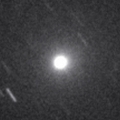
|
Outbursts occured repeatedly in this apparition. Another outburst occured in late July. Now it is very bright as 13.1 mag (July 24, Hidetaka Sato). It is observable in good condition in the evening sky in the Southern Hemisphere. It locates extremely low in the Northern Hemisphere, and will be unobservable soon.
Date(TT) R.A. (2000) Decl. Delta r Elong. m1 Best Time(A, h)
July 27 12 8.17 -11 41.1 2.480 2.213 63 15.2 18:42 (110, 44)
Aug. 3 12 20.61 -13 26.2 2.574 2.245 59 15.5 18:46 (104, 42)
|
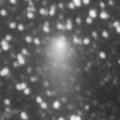
|
It kept bright as 11-13 mag for a long time from 2012 summer to 2013 summer. It will be fading after this. Now it is 14.8 mag (July 8, Sandor Szabo). In the Northern Hemisphere, it keeps observable for a long time until the comet fades out. In the Southern Hemisphere, it becomes low in late August, then it will be hardly observable.
Date(TT) R.A. (2000) Decl. Delta r Elong. m1 Best Time(A, h)
July 27 13 18.18 20 58.9 4.010 3.753 68 15.3 18:42 (152, 29)
Aug. 3 13 20.04 20 53.6 4.167 3.812 62 15.4 18:46 (145, 26)
|
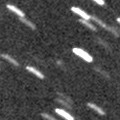
|
First return of a new periodic comet discovered in 1998. It brightened up to 10 mag at the discovery. Now it is 17.5 mag (July 12, K. Sarneczky, G. Marschalko). In the Northern Hemisphere, it keeps observable in excellent condition from autumn to spring. It locates somewhat low in the Southern Hemisphere.
Date(TT) R.A. (2000) Decl. Delta r Elong. m1 Best Time(A, h)
July 27 4 20.37 37 19.0 3.423 2.974 55 15.5 5:30 (210, 10)
Aug. 3 4 32.80 37 53.9 3.312 2.934 59 15.3 5:26 (208, 10)
|

|
Not observed yet in this apparition. It will brighten very rapidly near the perihelion passage. It is expected to reach up to 10 mag from autumn to winter. But actually, it is not detected, fainter than 20.5 mag on July 6 (Hidetaka Sato). In the Northern Hemipshere, it keeps observable in excellent condition until the comet fades out. In the Southern Hemisphere, it keeps observable in good condition within 2013, but it will not be observable in 2014.
Date(TT) R.A. (2000) Decl. Delta r Elong. m1 Best Time(A, h)
July 27 23 2.23 -17 35.1 1.279 2.176 142 15.7 2:44 (180, 73)
Aug. 3 23 0.16 -16 58.9 1.193 2.130 149 15.5 2:15 (180, 72)
|

|
Now it is 15.3 mag and visible visually (July 16, Sandor Szabo). It brightens up to 15.5 mag and will be observable in excellent condition from summer to autumn.
Date(TT) R.A. (2000) Decl. Delta r Elong. m1 Best Time(A, h)
July 27 21 34.85 -1 0.9 1.200 2.163 155 15.6 1:17 (180, 56)
Aug. 3 21 31.04 0 12.3 1.175 2.156 159 15.6 0:46 (180, 55)
|

|
Now it is 14.0 mag and visible visually (June 11, Sandor Szabo). It reaches up to 14-15 mag from spring to summer. It is observable in excellent condition in the Southern Hemisphere. It locates low in the Northern Hemisphere.
Date(TT) R.A. (2000) Decl. Delta r Elong. m1 Best Time(A, h)
July 27 12 48.51 -9 43.3 3.603 3.411 71 15.8 18:42 (121, 50)
Aug. 3 12 49.59 -8 36.9 3.742 3.423 64 15.9 18:46 (115, 44)
|
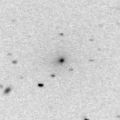
|
It brightened very rapidly. Now it is so bright as 14.0 mag (July 1, Hidetaka Sato). It keeps observable in good condition for a while in the Southern Hemipshere. It will never be observable again in the Northern Hemisphere.
Date(TT) R.A. (2000) Decl. Delta r Elong. m1 Best Time(A, h)
July 27 11 3.23 -20 31.8 2.445 2.049 55 15.9 18:42 ( 89, 36)
Aug. 3 11 0.87 -21 12.9 2.551 2.051 49 16.0 18:46 ( 83, 29)
|

|
It brightened up to 9.0 mag in 2012 autumn (Nov. 4, Juan Jose Gonzalez). However, it faded out unexpectedly around the perihelion passage. Now it is fainter than originally predicted by 4-5 mag. Now it is 15.2 mag (June 3, Hidetaka Sato). In the Southern Hemisphere, it keeps observable in good condition while fading slowly after this. In the Northern Hemisphere, it will not be observable after this.
Date(TT) R.A. (2000) Decl. Delta r Elong. m1 Best Time(A, h)
July 27 3 48.01 -45 12.3 2.846 3.020 89 16.1 5:30 (303, 65)
Aug. 3 3 54.57 -46 0.1 2.870 3.082 92 16.2 5:26 (307, 68)
|
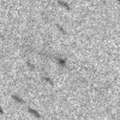
|
Now it is 17.1 mag (June 8, Ken-ichi Kadota). It is expected to be observable at 16 mag in good condition in summer and autumn.
Date(TT) R.A. (2000) Decl. Delta r Elong. m1 Best Time(A, h)
July 27 0 22.05 22 20.0 1.616 2.167 108 16.5 4:04 (180, 33)
Aug. 3 0 26.67 22 37.4 1.558 2.178 113 16.5 3:41 (180, 32)
|
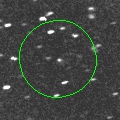
|
Brightening extremely rapidly. Now it is bright as 15.4 mag (July 15, J. Nicolas, F. Kugel). It will be observable at 16 mag in excellent condition in summer.
Date(TT) R.A. (2000) Decl. Delta r Elong. m1 Best Time(A, h)
July 27 15 28.33 -10 54.8 1.051 1.676 108 16.6 19:08 (180, 66)
Aug. 3 15 39.58 -12 57.6 1.095 1.674 104 16.6 18:52 (180, 68)
|

|
Now it is 16.4 mag (July 12, W. Hasubick). It keeps observable in good condition at 17 mag from spring to summer.
Date(TT) R.A. (2000) Decl. Delta r Elong. m1 Best Time(A, h)
July 27 18 24.47 -5 4.1 2.100 3.005 147 16.6 22:03 (180, 60)
Aug. 3 18 22.70 -5 13.3 2.159 3.019 141 16.7 21:34 (180, 60)
|
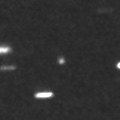
|
Now it is 16.8 mag (July 24, Hidetaka Sato). It is expected to brighten up to 7.5 mag and to be observable in excellent condition from summer to autumn in 2014 in the Southern Hemisphere. The condition is bad in the Northern Hemisphere. It will pass extremely close to Mars in 2014 October.
Date(TT) R.A. (2000) Decl. Delta r Elong. m1 Best Time(A, h)
July 27 5 27.67 -16 20.5 5.954 5.457 56 16.9 5:30 (264, 38)
Aug. 3 5 30.28 -17 0.3 5.819 5.394 60 16.8 5:26 (261, 42)
|

|
Now it is 17.1 mag (July 12, Hidetaka Sato). In the Southern Hemisphere, it keeps observable in good condition for a long time while fading gradually. It is not observable at all in the Northern Hemisphere.
Date(TT) R.A. (2000) Decl. Delta r Elong. m1 Best Time(A, h)
July 27 5 28.03 -41 4.1 5.064 4.864 72 16.9 5:30 (295, 47)
Aug. 3 5 33.47 -41 11.4 5.069 4.899 74 16.9 5:26 (294, 50)
|

|
First return of a new periodic comet discovered in 2005. It was expected to be observable at 17 mag for a long time from 2013 to 2014. However, it has not been recovered yet. Actually, it is much fainter than predicted, fainter than 20.5 mag (June 8, Danilo Pivato).
Date(TT) R.A. (2000) Decl. Delta r Elong. m1 Best Time(A, h)
July 27 16 39.73 -14 8.2 2.499 3.203 126 17.1 20:19 (180, 69)
Aug. 3 16 40.00 -14 31.7 2.573 3.198 119 17.2 19:52 (180, 70)
|
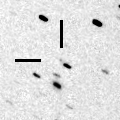
|
Now it is 18.1 mag (June 13, Mt. Lemmon Survey). It is brighter than originally expected by 1 mag. It will brighten up to 16.5 mag and will be observable in good condition from summer to autumn.
Date(TT) R.A. (2000) Decl. Delta r Elong. m1 Best Time(A, h)
July 27 0 35.94 6 7.9 1.359 1.992 113 17.4 4:17 (180, 49)
Aug. 3 0 38.07 8 40.1 1.289 1.984 118 17.2 3:52 (180, 46)
|
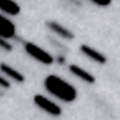
|
It was observed at 18 mag in 2012. It will be observable at 17 mag in excellent condition in 2013.
Date(TT) R.A. (2000) Decl. Delta r Elong. m1 Best Time(A, h)
July 27 0 30.81 14 59.7 3.894 4.355 110 17.3 4:13 (180, 40)
Aug. 3 0 26.14 13 47.1 3.780 4.359 118 17.3 3:40 (180, 41)
|

|
Now it is 17.4 mag (June 15, K. Hills). It keeps 17 mag for a long time from 2012 to 2013, and will be observable in good condition in the Southern Hemisphere. It is not observable at all in the Northern Hemisphere.
Date(TT) R.A. (2000) Decl. Delta r Elong. m1 Best Time(A, h)
July 27 1 44.48 -73 10.0 4.561 5.021 111 17.3 5:26 ( 0, 52)
Aug. 3 1 26.63 -74 35.5 4.558 5.035 112 17.3 4:41 ( 0, 51)
|

|
It was observed at 15-16 mag in 2012. Now it is fading. It has already faded down to 16.9 mag (June 30, J. F. Soulier). It will be fainter than 18 mag in autumn. It locates low in the Southern Hemisphere.
Date(TT) R.A. (2000) Decl. Delta r Elong. m1 Best Time(A, h)
July 27 2 14.83 38 23.6 4.312 4.257 80 17.4 5:30 (185, 16)
Aug. 3 2 12.02 38 6.0 4.225 4.291 86 17.4 5:26 (180, 17)
|
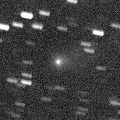
|
It brightened up to 15.5 mag in 2012 summer. Although it has already passed the perihelion, it tends to become brightest after the perihelion passage. Now it is 18.6 mag, fainter than this ephemeris (June 20, A. Maury, J. F. Soulier).
Date(TT) R.A. (2000) Decl. Delta r Elong. m1 Best Time(A, h)
July 27 22 34.55 -20 20.4 2.769 3.681 149 17.5 2:17 (180, 75)
Aug. 3 22 31.32 -20 57.0 2.746 3.698 156 17.6 1:46 (180, 76)
|

|
Now it is 17.4 mag (June 29, Jean-Francois Soulier). It has brightened in outburst up to 14 mag twice, in 2006 January and 2011 May. It will pass the perihelion in 2015. It keeps observable at 17 mag for a long time after this.
Date(TT) R.A. (2000) Decl. Delta r Elong. m1 Best Time(A, h)
July 27 18 57.14 -18 5.6 5.580 6.539 159 17.6 22:36 (180, 73)
Aug. 3 18 54.78 -18 12.0 5.611 6.524 152 17.7 22:06 (180, 73)
|

|
It keeps 17 mag for a long time from 2013 summer to early 2015.
Date(TT) R.A. (2000) Decl. Delta r Elong. m1 Best Time(A, h)
July 27 1 58.88 16 31.3 3.124 3.294 90 17.7 5:30 (183, 38)
Aug. 3 2 3.59 16 59.2 3.015 3.280 96 17.6 5:17 (180, 38)
|
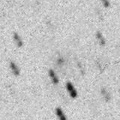
|
Because it is a very distant comet, it will be fading very slowly. It keeps observable at 17.5 mag in 2013.
Date(TT) R.A. (2000) Decl. Delta r Elong. m1 Best Time(A, h)
July 27 23 24.23 11 3.8 9.136 9.774 126 17.7 3:06 (180, 44)
Aug. 3 23 23.31 10 52.3 9.060 9.781 133 17.7 2:38 (180, 44)
|
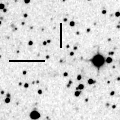
|
Now it is 17.7 mag (June 10, P. Lindner). It is expected to brighten up to 14 mag from 2015 to 2016.
Date(TT) R.A. (2000) Decl. Delta r Elong. m1 Best Time(A, h)
July 27 17 39.52 -2 30.6 7.765 8.527 136 17.8 21:18 (180, 58)
Aug. 3 17 38.12 -2 42.1 7.803 8.493 130 17.8 20:49 (180, 58)
|

|
It will brighten up to 14 mag around the perihelion passage in 2019. In 2013, it will be observable in good condition at 17.5 mag from summer to winter. It locates low in the Southern Hemisphere.
Date(TT) R.A. (2000) Decl. Delta r Elong. m1 Best Time(A, h)
July 27 3 10.60 25 21.4 14.475 14.193 71 17.8 5:30 (201, 27)
Aug. 3 3 11.28 25 34.6 14.333 14.164 78 17.8 5:26 (195, 28)
|
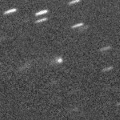
|
It has been observed at 17 mag for a long time from 2009 to 2012. It is also observable at 18 mag in good condition in 2013.
Date(TT) R.A. (2000) Decl. Delta r Elong. m1 Best Time(A, h)
July 27 22 1.05 8 6.1 8.441 9.280 143 17.8 1:43 (180, 47)
Aug. 3 21 56.81 7 50.1 8.408 9.301 150 17.8 1:12 (180, 47)
|
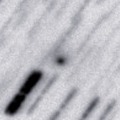
|
It brightened up to 2 mag by unusual major outburst in 2007. It was observed around aphelion at 22 mag. It will return in 2014. It will be 14 mag at best by normal prediction. Now it is 16.6 mag, brighter than this ephemeris (July 17, A. Maury, J. F. Soulier).
Date(TT) R.A. (2000) Decl. Delta r Elong. m1 Best Time(A, h)
July 27 16 52.54 -44 26.8 1.967 2.727 129 17.9 20:32 ( 0, 81)
Aug. 3 16 51.52 -43 19.7 2.001 2.697 123 17.9 20:03 ( 0, 82)
|
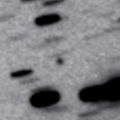
|
It keeps observable at 18 mag for a long time from 2013 to 2016. It keeps locating high in the Northern Hemisphere. It keeps locating very low in the Southern Hemipshere.
Date(TT) R.A. (2000) Decl. Delta r Elong. m1 Best Time(A, h)
July 27 19 15.77 26 49.9 6.264 6.972 130 17.9 22:54 (180, 28)
Aug. 3 19 9.78 26 56.2 6.271 6.954 129 17.9 22:20 (180, 28)
|
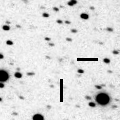
|
It was discovered in 1819, and re-discovered in 2003. Although it was predicted to be extremely faint as 26 mag, it unusually brightened up to 17.5 mag in outburst (July 6, Hidetaka Sato). It will pass the perihelion in 2014 August, and will approach to the sun down to 0.96 a.u. The brightness is predicted to be 23 mag at best. However, if the cometary activity continues, it may be observed brighter.
Date(TT) R.A. (2000) Decl. Delta r Elong. m1 Best Time(A, h)
July 27 19 20.50 -27 40.6 2.791 3.774 162 18.3 22:59 (180, 83)
Aug. 3 19 13.71 -27 53.0 2.793 3.738 155 18.5 22:24 (180, 83)
|
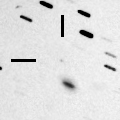
|
Although it was expected to be bright as 16 mag, actually it was so faint as 19.3 mag, fainter than expected by 3 mag (July 3, Hidetaka Sato). It will be observable in good condition from summer to autumn, however, it will be only 19 mag at best.
Date(TT) R.A. (2000) Decl. Delta r Elong. m1 Best Time(A, h)
July 27 2 31.77 16 58.0 1.088 1.394 82 18.6 5:30 (193, 37)
Aug. 3 2 53.14 18 39.6 1.064 1.395 84 18.6 5:26 (192, 35)
|

|
It was predicted to be 17 mag. But actually, it is much fainter, 19.1 mag (June 30, J. Gonzalez.
Date(TT) R.A. (2000) Decl. Delta r Elong. m1 Best Time(A, h)
July 27 17 48.46 -12 17.8 1.893 2.763 141 18.8 21:27 (180, 67)
Aug. 3 17 47.24 -12 9.5 1.964 2.776 135 18.9 20:59 (180, 67)
|

|
First return of a new periodic comet discovered in 1998. Now it is 18.6 mag (July 24, Siding Spring Survey). It is fainter than originally expected by 2 mag. It was expected to be observable at 15.5 mag in good condition from 2013 autumn to early 2014. But actually, it will be 17 mag at best.
Date(TT) R.A. (2000) Decl. Delta r Elong. m1 Best Time(A, h)
July 27 1 51.77 -19 9.7 2.556 2.966 103 19.0 5:30 (182, 74)
Aug. 3 1 57.70 -19 39.1 2.457 2.938 108 18.8 5:11 (180, 75)
|
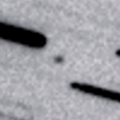
|
It was expected to brighten up to 15 mag in 2013 summer. But actually, it is so faint as 19.5 mag, fainter than expected by 4 mag (July 2, J. F. Soulier).
Date(TT) R.A. (2000) Decl. Delta r Elong. m1 Best Time(A, h)
July 27 21 25.64 18 32.6 1.213 2.091 139 18.9 1:10 (180, 36)
Aug. 3 20 42.42 14 45.7 1.167 2.095 147 18.9 23:49 (180, 41)
|
|
![]()
 C/2011 L4 ( PanSTARRS )
C/2011 L4 ( PanSTARRS ) 26P/Grigg-Skjellerup
26P/Grigg-Skjellerup C/2012 V2 ( LINEAR )
C/2012 V2 ( LINEAR ) C/2013 N4 ( Borisov )
C/2013 N4 ( Borisov ) C/2012 S1 ( ISON )
C/2012 S1 ( ISON ) C/2012 L2 ( LINEAR )
C/2012 L2 ( LINEAR ) 246P/2010 V2 ( NEAT )
246P/2010 V2 ( NEAT ) C/2010 S1 ( LINEAR )
C/2010 S1 ( LINEAR ) C/2006 S3 ( LONEOS )
C/2006 S3 ( LONEOS ) C/2013 G5 ( Catalina )
C/2013 G5 ( Catalina ) 29P/Schwassmann-Wachmann 1
29P/Schwassmann-Wachmann 1 C/2011 J2 ( LINEAR )
C/2011 J2 ( LINEAR ) (596) Scheila
(596) Scheila C/2012 S3 ( PanSTARRS )
C/2012 S3 ( PanSTARRS ) C/2012 K1 ( PanSTARRS )
C/2012 K1 ( PanSTARRS ) C/2013 E2 ( Iwamoto )
C/2013 E2 ( Iwamoto ) 117P/Helin-Roman-Alu 1
117P/Helin-Roman-Alu 1 P/2013 CU129 ( PanSTARRS )
P/2013 CU129 ( PanSTARRS ) C/2009 F4 ( McNaught )
C/2009 F4 ( McNaught ) 63P/Wild 1
63P/Wild 1 C/2011 R1 ( McNaught )
C/2011 R1 ( McNaught ) 290P/2013 N1 ( Jager )
290P/2013 N1 ( Jager ) 154P/Brewington
154P/Brewington P/2013 J2 ( McNaught )
P/2013 J2 ( McNaught ) C/2012 K6 ( McNaught )
C/2012 K6 ( McNaught ) C/2013 G6 ( Lemmon )
C/2013 G6 ( Lemmon ) C/2011 F1 ( LINEAR )
C/2011 F1 ( LINEAR ) 257P/2012 F4 ( Catalina )
257P/2012 F4 ( Catalina ) 98P/Takamizawa
98P/Takamizawa P/2012 F2 ( PanSTARRS )
P/2012 F2 ( PanSTARRS ) C/2013 A1 ( Siding Spring )
C/2013 A1 ( Siding Spring ) C/2011 O1 ( LINEAR )
C/2011 O1 ( LINEAR ) P/2005 L1 ( McNaught )
P/2005 L1 ( McNaught ) 102P/Shoemaker 1
102P/Shoemaker 1 C/2012 S4 ( PanSTARRS )
C/2012 S4 ( PanSTARRS ) C/2012 C1 ( McNaught )
C/2012 C1 ( McNaught ) C/2012 A2 ( LINEAR )
C/2012 A2 ( LINEAR ) 152P/Helin-Lawrence
152P/Helin-Lawrence 174P/(60558) 2000 EC98 ( Echeclus )
174P/(60558) 2000 EC98 ( Echeclus ) 119P/Parker-Hartley
119P/Parker-Hartley C/2012 Q1 ( Kowalski )
C/2012 Q1 ( Kowalski ) C/2011 KP36 ( Spacewatch )
C/2011 KP36 ( Spacewatch ) C/2010 U3 ( Boattini )
C/2010 U3 ( Boattini ) C/2008 S3 ( Boattini )
C/2008 S3 ( Boattini ) 17P/Holmes
17P/Holmes C/2012 K8 ( Lemmon )
C/2012 K8 ( Lemmon ) 289P/Blanpain
289P/Blanpain 184P/Lovas 2
184P/Lovas 2 91P/Russell 3
91P/Russell 3 292P/2013 O1 ( Li )
292P/2013 O1 ( Li ) C/2012 V1 ( PanSTARRS )
C/2012 V1 ( PanSTARRS )![]()
















































